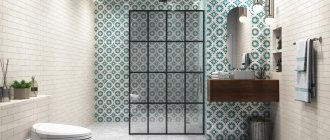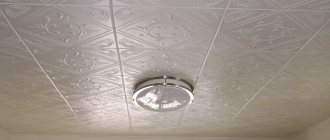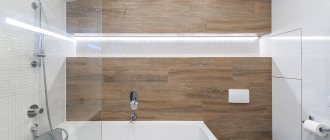Do you have a renovation in your life and want to decorate your kitchen or backsplash with white tiles? Usually at this stage doubts arise about what color to decorate the seams, because white will quickly “fail.” One of the latest trends in decorating is white tiles with black grout: it looks stylish and is also a very practical solution.
What's good about white tiles?
There are a lot of advantages. The strongest ones were chosen.
- Pairs with anything. Loyal to any color of grout and to a wide variety of companions: paint, plaster, microcement, wallpaper, wood and other materials.
- Suitable for bathrooms in any style - from minimalism to art deco and classics.
- Without getting dirty (no matter how strange it may sound). Soap stains, lime water, particles of dust and washing powder and other dirt in the bathroom in general are always grayish white in color. On light surfaces all this will be much less noticeable than on dark ones.
- Adds light and air. And in the bathroom, where there are not so often windows and daylight, white is a saving breath of air for those who feel comfortable only in bright interiors.
What are the types of grout mixtures: types, differences, pros and cons
The most common are dry mixtures. Manufacturers use cement with various additives as their base; they make the grout plastic, easy to use, water-repellent, etc. The powder can be used only after dilution (water, less often liquid latex), the proportions are always indicated on the packaging.
There are also synthetic types. They are immediately ready for use; usually you don’t need to add anything, but there are also those that require mixing with a hardener or dye.
Synthetic grout should be prepared right before work, and the process itself should not be interrupted.
In any case, the action is approximately the same: the mass is introduced into the spaces between the tiles, hardens, fastening the edges together. The result is a thick protective layer that does not allow moisture and air to destroy the integrity of the cladding.
Cement grouts
This type includes all grouting masses, the basis of which is a cement-sand or cement-polymer mixture. The composition allows you to use this option for gaps of different depths and widths. The affordable price makes this type the most popular and widespread.
| pros | Minuses |
| Relatively low price. | Poor color palette due to the properties of the base material. |
| High strength, resistance to washout. | It takes a very long time to dry and shrinks slightly after drying completely. |
| It takes a long time to harden, but if the work was done with flaws, you can correct them without consequences. | The porous structure makes it impossible to use cement grout without antiseptic substances in a damp room (bathroom, bathhouse, etc.). |
| Easy to fix if the seam breaks over time. |
Epoxy and furan resin grouts
This option is a two-component one. Synthetic resin is combined with fine-grained colored sand, which not only further strengthens the seam, but also gives the desired color. After mixing the parts, the material becomes similar to chewing gum, and in its properties - like good plastic. Epoxy grouts are ideal for working on areas of high humidity and are equally good for kitchens and pools.
As for furan mixtures, they can only be used in production, it is rarely found on sale and exists only in black.
| pros | Minuses |
| 100% waterproof. Zero porosity, which means neither dirt nor moisture is a problem. | Significantly more expensive than other options. Often it is the high cost that cancels out all the many advantages. |
| Suitable for rooms that require frequent disinfection with strong detergents. Not afraid of powders or rough cleaning. | The mixture is easy to prepare, but working with it requires skill. You cannot hesitate and make mistakes, since the rate of hardening is very high. |
| For such grouts, neither open fire nor icy wind is dangerous. No temperature changes will affect the color. Manufacturers guarantee the safety of the coating for at least 30-50 years. | Slight surface roughness (due to fine sand in the composition) can create inconvenience, for example, when cleaning. |
| It can take on any color and highlight the most unexpected interior design. Sequins, rhinestones, luminescent glow? | Furan grout is not safe and cannot be used in apartments and houses where people and animals live. Only production premises with good ventilation. |
Silicone grout
Another type of grout that is ideal for fine work. The silicone base does not allow moisture or air to pass through, adheres well and is not destroyed when exposed to most modern detergents (except chlorine).
| pros | Minuses |
| The grout is relatively easy to work with and hardens quite slowly, allowing you to correct any unevenness. | When disinfected with chlorine products, it is gradually destroyed. |
| If necessary, it can be easily removed without leaving any traces. | |
| Suitable for wet areas, strong and durable. |
Latex grout
One of the expensive mixtures, which is usually not used in its pure form. Latex grout is purchased either to dilute the cement base, or is applied to the finished, dried seam after shrinkage. The latex finish significantly increases the wear resistance of cement grout and makes it waterproof.
| pros | Minuses |
| Good elasticity makes the latex grout mixture durable and not prone to cracking. | Expensive. |
| Suitable for wide gaps (up to 3 cm). | It is necessary to immediately clean up the flaws, otherwise the tile will become cloudy forever in the place where the mixture has dried. |
| Lots of shades. Hundreds of color options available. |
How to choose high-quality white tiles?
Traditionally, Spanish and Italian brands have the most reliable reputation. But to determine the quality, one made in Italy badge is not enough. And then, it turns out that tiles from other countries are worse by default? Of course not! To determine whether the tile is really of high quality, check with a consultant in the salon to find out what standards and tolerances it meets. Here are the most authoritative and reliable:
- DIN (Germany)
- UPEG (France)
- BS (UK)
- ASTM-ANSI (USA)
- UNI EN (Italy)
These tolerances ensure that the product is rigorously tested for wear resistance, has good geometry, low porosity and low water absorption, high strength and other important quality indicators. There is no doubt about such tiles, and the color will be uniform, bright, without yellowness or a grayish tint.
Grout color range
Ceresit
Excellent, wear-resistant grout. Ceresite is very popular, especially CE-40, with moisture-reflecting properties. The color palette is huge; only a lazy person wouldn’t choose one of the colors presented. But, reviews say that the color on the package (except for neutral shades) may differ slightly from the actual one. Therefore, it is wise to try it on a small, inconspicuous area.
Litokol
Probably, Litokol grouts have the largest palette of colors among ordinary, non-epoxy compounds. But, unlike the previous brand, Litokol reflects the real shade on the packaging as accurately as possible.
Atlas
Another popular hero of today's material is Atlas grout. A wide selection of colors that look gentle, very soft. The brand offers not only regular grout, but also:
In general, reviews from this brand are very good; there are no complaints about the differences in the palette and the actual color.
Kiilto
This brand has collected the largest number of positive reviews among all those listed above (non-epoxy grout). It is good in literally everything: a rich palette, good, soft shades, correct reproduction of the final shade in the house as presented on the packaging.
Two-component grout
If finances allow it and you know craftsmen who work with epoxy grout, you should definitely choose it among others. This grout is suitable for any room; it does not fade, chip, or crack for decades. But, most importantly, there is a huge selection of colors, shades, effects (glitter, glitter, shimmering particles). By choosing epoxy grout, you can bring absolutely any interior design idea to life.
Main functions of grout
Once you have already decided on the tile, you need to choose the right grout color. It is designed to perform the following functions:
- protect building materials from moisture penetration;
- eliminate temperature gaps;
- decorate the surface.
The main task of the grout is to protect against moisture getting under the tiles.
Due to the fact that high humidity prevails in the bathroom, it is worth focusing on protecting the tiles from premature destruction. The putty is applied to the tile joints to ensure the tightness of the building material.
If there is high moisture in the room, it is worth caulking the seams to prevent premature destruction of the material.
Resin based grouts
There is also a fugue based on resin. It is divided into fugue based on epoxy and furan resins. Epoxy grout for tiles is used in those rooms where there is constant contact of the tile surface not only with water, but also with various household chemicals.
Cement compounds cannot cope with what epoxy can cope with, because epoxy fugue is two-component and combines, among other things, a cement base.
In appearance it is practically indistinguishable from cement grout. Also, moisture falling on the surface simply rolls off, while in a cement fugue it is absorbed.
In addition to rooms with high moisture using household chemicals, this type of grout is used for grouting absolutely all types of tiles, as well as natural stone tiles. Sometimes it is used for grouting joints over a heated floor, but this is more likely due to aesthetic parameters.
The advantages of such a fugue include:
- Very long service life.
- Does not fade when exposed to UV rays.
- The temperature withstandable by this composition ranges from -20 to +90 degrees, which makes it very resistant to different climates.
- Resistant to household chemicals and mild acids and alkalis.
The main disadvantage is the price of such a fugue, as well as the complexity and some problems during dismantling.
In the case of cement fugue, it depends on how the composition itself is diluted. Also, when performing work, special tools and chemicals are used, which also indicates the need for the ability to work with such grout.
Color combination options
Thanks to well-chosen color combinations, you can get three options for effects:
- One color. It is the simplest tandem, which is a single whole. A one-color combination is perfect for those who like a laconic, not too catchy design, and also allows you to mask some finishing imperfections in the form of uneven joints or chips.
- Contrasting grout. Gives the environment a special expressiveness and favorably emphasizes the geometry and laying of tile elements, giving them a deeper and richer look.
- Shades. Using this solution, you can unobtrusively highlight the geometric shape, pattern and color of the cladding, thereby creating a calm, expressive design.
The photo shows a bathroom interior with contrasting grout for wall and floor tiles.
Currently, there are collections of tiled models that already have a tinted putty solution. Most often, such a color palette is particularly original, for example, a black finish is complemented by a pearl-white fugue, a beige finish is complemented by grout in chocolate tones, and an olive finish is complemented by graphite.
Methods for selecting shades
To correctly determine which grout is suitable for tiles in the kitchen or bathroom, compare the available options. Colors are chosen in different ways:
- to match ceramic tiles;
- colorless;
- play with bright contrast;
- shade the tiles;
- to match the painting of the adjacent wall.
To create the effect of a solid monolithic surface, choose materials that closely match the color of the cladding. In this way, it will be possible to disguise the joints, including flaws.
The best way to hide seams is to use a flashy grout
To highlight individual fragments and create volume, a mass of slightly different shades is used, and for bright accents, completely mismatched colors are used, however, such techniques are used with caution. They select contrasts to match the surrounding interior items; in the bathroom, the ideal solution is neutral white, in harmony with the plumbing.
Grout color palette
Different manufacturers have different color palettes. In basic colors like white, several grays and black, they overlap, but in others they differ significantly.
Grout Ceresit colors
The most commonly used grout in the CIS countries is ceresit. They have several types of grout CE 33, CE 40 and CE 25. The most commonly used grout is Ceresit CE 40 and it has the widest range of colors. Ceresite CE 40 holds moisture and minor deformations well, which means it is less likely to crack due to minor shrinkage and vibrations. Quite a good choice, but there are some nuances in the colors.
Everything is clear with neutral colors; you can get an idea about them by looking at the sticker on the jar or bag. But with more complex flowers, for example Jasmine, Crocus, Sahara and some others, strange things happen. The actual color after grouting and drying is not at all similar to what is indicated on the can.
Perhaps they are fundamentally different, perhaps the printing house conveys it poorly, but the fact remains: the choice of Ceresit grout color must be made after a trial application and drying. Yes, this complicates the process somewhat, but it is better to first buy a minimum amount, apply and let it dry, and then buy everything else. How to immediately wipe all the seams, and in fact remain dissatisfied with the resulting color.
Litokol grout colors
The Litokol brand has perhaps the widest range of grout types and color palette. We will mention their epoxy options later, because... they are not very popular due to their high price. But their line of regular grouts deserves attention.
Their Litochrom line includes, among other things, grout in our favorite gray colors in the amount of 4 pieces. We used all 4 in one apartment for different surfaces. There were no problems with them. What is important is that the color of the sticker on the packaging very closely reflects the final color of the seams after drying. Although Ceresit had no problems with the grays either.
Litokol C.10 gray and C.30 pearl gray can be used as basic universal grout colors.
Grout Satin colors
Another popular grout brand. It is used widely and the reviews are generally good. We have no experience working with it, so we’ll just give you a palette of Atlas grout colors.
Kiilto grout colors
Unfortunately, I also have no experience of using it, but I don’t want to invent it. But the Kiilto color palette is quite wide, we’ll just give it here. If you have experience using this or any other grout, please share it in the comments.
Two-component grout
It's very expensive. This type of epoxy grout is not particularly popular due to its price. In addition to the price, it is difficult to apply, difficult to remove excess residue and wash. If you have a decent budget and your builders have experience working with epoxy grouts, then they should be your choice. They are much more resistant to dirt and are not afraid of moisture at all.
And most importantly, epoxy grouts have a huge number of colors. Including all sorts of glosses, sparkles and even options that glow in the dark. The Litokol brand has a wide range of epoxy grouts. But all this is beyond the scope of this article.
Conclusions on what color of grout to use:
- The color of the tiles is darker for the floor and lighter for the walls.
- If you can’t find it in color, then use gray that matches in tone.
- White only for white tiles, only on the walls and not in the kitchen.
What you should pay attention to when selecting grout
The main criterion is the performance characteristics of the material and the purpose of the room where the finishing will be carried out, but there are other equally important parameters. In general, you need to decide on the following values:
- Depth and width of joints between tiles;
- The purpose of the room where the finishing will be done (this includes the level of humidity, temperature conditions, contact with water and chemicals);
- Purpose for interior or exterior work;
- Color scheme and decorative inclusions (sparkles);
- Additional characteristics (substances against fungi and mold, dry or ready-made mixture).
On what basis should I use the grout mixture?
Grout can be made from cement, silicone and epoxy resin. Each option has its own advantages and disadvantages. Let's briefly consider each option.
Cement based grout.
An improved version of the previously widely used simple cement mortar for filling tile joints. Modern grouts contain various additives that significantly increase their characteristics (ductility, antifungal additives).
The main advantages of high-quality cement mixtures are that they are easy to use (easier to wipe off tiles, penetrate well into the seams between tiles, easier to renew grout joints) and are relatively cheap compared to grouts on other bases.
Another thing is that cement grouts, as a rule, are afraid of constant contact with water (they will absorb water and begin to crumble), absorb fats, may lose color over time and are afraid of contact with chemicals. Therefore, when used in a bathroom or especially on a kitchen backsplash, it is recommended to use special impregnations for grout (they eliminate the main disadvantages of cement grout). It still turns out cheaper than using expensive but almost eternal epoxy grout.
Epoxy grout
The leader among grout mixtures for grouting joints. They are practically devoid of the disadvantages that other products have, for example, cement-based ones.
Epoxy grout matched to the mosaic tone with the addition of glitter.
The advantages include:
- is not afraid of moisture, therefore it is used in swimming pools, saunas and other places with constant contact with water;
- does not fade (can be used for exterior decoration);
- resistant to strong chemicals and does not absorb fats and dirt;
- no mold appears;
- durable;
- high decorative qualities in the presence of sparkles;
- there is no need for treatment with special impregnations and periodic renewal, as with cement grout.
Main disadvantages:
- High price
- Difficulty of work: if you do not remove the grout from the tiles in time and let it set, then there is practically nothing to remove it (especially from structural tiles), it is also viscous and it is difficult to seal the seams if you do not have experience.
Silicone, polyurethane or acrylic “grout” (sealants)
There is an opinion that sealants can be used to seal tile joints, but professionals still do not recommend this. Yes, they do not require special preliminary preparation and are convenient because they are applied using special syringes, but the original purpose of sealants is that they fill the joints between the tiles and, for example, a sink or bathtub. Over time, the sealant turns yellow and moisture causes mold and mildew to form on it. If you nevertheless decide to use a sealant to seal seams, for example, at the joints of walls, then it is better to take a polyurethane one that is not transparent (tile adhesive and debris will be visible).
A brief summary of the above is presented in the table.
Based on these characteristics, you can already decide which tile grout is best suited for your purposes.
Which grout is suitable for light-colored tiles?
For classic white tile cladding, you can choose contrasting black or brown grout. The combination with red, burgundy fugue, as well as combinations with pastel peach, mint, pink, blue or blue grout are no less bold and impressive. Beige tiles go well with neutral chocolate, gray, milky tones or a darker fugue of black.
The photo shows a white tiled wall with a blue fugue.
Light blue tile finishes can be emphasized with white, yellow or dark blue colors.
The photo shows a bathroom with walls covered in blue tiles with white grout.
Varieties
Ceramics are used in the hygiene room, because this is a room with high humidity and constant temperature fluctuations. The tiles are not afraid of moisture and are easy to install. But, with any cladding, there are always gaps between the tiles. Water, dirt, and mold can get into them. Therefore, the role of grouting mixtures is so important. You can figure out which grout is best for bathroom tiles by looking at the varieties of this material:
Contains additional components that increase moisture resistance and strength properties
The basis of the durable material is resin
Furan resin protects against chemicals and moisture. Expensive mixture
The choice of grout for bathroom tiles depends not only on the properties of the material. The color of the mixture is important. For some time, only white formulations were available. Manufacturers now offer a large selection of color shades of grout materials.
To find the perfect color grout, take a sample of the tiles with you to the store. This makes it easier to choose the right shade.
White tiles
When the room is already tiled, it is important to choose the right grout mixture to match the color. Before purchasing, decide how you want the bathroom to look. Perhaps it will be a contrasting cladding or, conversely, the seams will be sealed to match the ceramic.
White color has always been considered universal, suitable for any shade. But, if the tile itself is white, how to choose grout for the tile?
What grout color should I choose for white tiles to make the cladding look more impressive? The best options are:
- play on sharp contrasts;
- pure white (creating the effect of one, clean coating).
If you have any doubts about which grout to choose for white tiles, then immediately abandon beige and gray shades. So the cladding, and along with it the grout for white tiles, will seem dirty and unsightly.
Beige tiles
Look at the photo for the grout color for beige tiles. Here are the views of experts as follows:
- It is better to choose mixtures slightly darker than tiles. This way you can emphasize the delicate shade of ceramics;
- the tiled shade is lighter, so it will look better against the background of darker seams;
- It is advisable to select the tones of the grout in light colors with a brown or orange tint.
What color of grout to choose for beige tiles also depends on the color of the plumbing fixtures and the style of the interior - everything should be combined.
If it is too difficult to decide which grout to choose for beige tiles, then settle on the optimal solution - white or a very light tone of gray.
White tiles with dark grout
It will favorably emphasize the positive aspects of the bathroom design and hide possible defects in the renovation work. White tiles with dark grout do not need frequent repairs, as they are less susceptible to contamination. With the same success, the seams can be covered with a gray mixture. But with black grout the walls will look more original.
This option is very profitable. Using this approach you can hide defects
To make the appearance of the room unique, it is worth considering color options. But if any defects remain after construction work, then be prepared for the fact that they may appear.
White tiles with colored grout will make the design more original. For everything to look organic, it must repeat the tones of furniture or plumbing fixtures. By manipulating the color of the grout paste, you can create an attractive checkerboard effect.
Colored grout will add a little variety to the interior
Peculiarities
Grout for joints is used when carrying out finishing work using tiles. After tiling, the surface is usually left alone for 24 hours so that the glue is completely dry, and after a day the seams are filled with grout.
Grout mixtures are available in two types:
- Dry - usually these are the simplest cement-based compositions with the addition of mineral components. To work, they are dissolved with water or liquid latex in the proportions indicated on the packaging.
- Liquid – mixtures obtained from resins. They can be ready for use, or they can be brought to the desired condition with special hardeners.
The main performance characteristics of all types of grout include:
Water resistance. The composition is characterized by water-repellent properties; it forms a solid substance, eliminating deep penetration and retention of moisture.
- Wide palette of shades. The range of leading grout manufacturers offers a variety of colors from white to black (blue, green, red, pink, light blue and others).
- Plastic. During operation, the mixture does not spread, and the treated seams remain smooth.
- Color stability. The grout is resistant to exposure to sunlight; over time it does not fade or change its shade, maintaining the brightness and richness of the colors.
- Smooth surface. The mixture forms a strong and smooth surface without bumps or other irregularities. This improves the quality of the coating and the overall aesthetic appearance of the room.
- Resistance to temperature fluctuations. The grout does not change its properties when exposed to high and low temperatures and can be used in unheated rooms.
Advantages and disadvantages of dark seams
Light tiles with dark grout can be used in different cases. At the same time, before choosing a color solution, you should understand the positive and negative sides of the issue. The advantages include:
- Stylish and modern solution;
- Highlights tiles;
- A beautiful appearance lasts longer.
The disadvantages are:
- Highlights shortcomings if they were made when laying the tile material;
- Cannot be applied to all design styles;
- Can add gloominess to a room.
Light tiles with dark grout can be used in different cases.
Market news
The choice of grout in the bathroom does not end there. In addition to the options described, on the modern market of finishing materials there are samples that have appeared on sale relatively recently. These include the following compositions:
- transparent;
- mother-of-pearl;
- with sparkles;
- tint translucent;
- fluorescent.
It is better to use colorless and shiny ones with mosaic tiles, glass and onyx.
New interior fashion
Transparent and translucent compositions are often made on the basis of liquid glass or epoxy resins. Varnishes and other modifying additives are also added to them. Such grouts are used for glass and glazed glossy products. The adhesive base is of great importance, because it is visible through the outside. In this case, it is recommended to lay the tiles on a white mortar.
Choosing between black and gray
Black is a demanding color; it cannot be used in a room where this color is not present anywhere else. If you want to grout the seams in black, then you need to take care of installing interior items of the same color. Otherwise, there is a chance of creating a bright accent that will unnecessarily stand out from the overall design.
If you want to grout the seams in black, then you need to take care of installing interior items of the same color.
White tiles with gray grout are a more universal solution; the color will not attract too much attention, and there is no need to install gray objects around the room. However, you can improve the style by using gray curtains or choosing gray tableware.
White tiles with gray grout are a more universal solution.
The importance of choosing the right grout for joints
The importance is due not only to the aesthetic component of working with ceramics. Yes, the surface treated with grout looks complete and neat, but, from the point of view of usefulness, grout mixtures play several more roles:
In addition to the listed factors, the work process itself is also important. A good solution is easy to apply, it is flexible and does not cause any inconvenience to the master. Some grout materials retain this property even after drying. The seams will not crack over time from drying out, which means the cladding will not lose its properties.
Tip: Do not use white grout on the floor. It quickly turns yellow, loses its appearance and turns more into an irritant than into the pride of its owners.
Other color options
Not all colors are suitable for grouting white tiles. Using beige, cream and other light shades will make the surface feel dirty. Therefore, they should not be selected.
You can use not only the standard white, black and gray colors for this purpose, but also brighter and more contrasting colors - red, blue, yellow, etc. But in this case, you should definitely take care of combining them with objects in the room; the chosen color should also be present on other products so as not to get bored over time.
If you decide to make an unusual tile layout, then only dark grout can highlight such a design; using white is inappropriate.
If black is too dark for the owner of the room, then you can use dark green and dark blue mastic mortar for the joints. Brown shades will add warmth to the finish.
You can use not only standard grouts, but also brighter and more contrasting ones - red, blue, yellow, etc.
Assortment - what options to consider?
How to choose the COLOR AND TONE OF GROUT? You need to mix it.
Manufacturers offer fillers with a sand or resin base. There is also a wide selection of silicone sealants on sale. It is necessary to mention the various variations and subspecies. For example, cement mixtures can have the following compositions:
- sand + Portland cement;
- portland.
Grout to which sand is added can cause damage to the surface. If you are going to fill the seams of tiles covered with glaze or enamel, or marble, then you need to avoid this option. By the way, sand solutions have a poor color range: they are either white or with a yellowish tint.
To be sure of high quality results, choose a material with latex and polymers. The resin filler may contain:
- furan resins;
- epoxy + Portland cement.
Tile grout
However, such compositions can only be used in industrial premises. Before purchasing a particular product, you should look not only at its color and shade. But also on the information on the packaging, in particular, on the purpose of the material.
The question of choosing the color of grout for ceramic tiles plays a huge role in the aesthetic perception of the tiled surface. There are many types of mixtures, approaches differ in taste preferences, and therefore there is no definite answer. But you can give a few recommendations to help you make the best choice.
Today, a variety of grouts allows you to choose a color to suit any interior.
Recommendations for choosing a composition
The constituent components that are used in grout mixtures are responsible for the properties of the resulting joints. Therefore, their selection should be made not only on the basis of color preference, but also taking this factor into account.
There are a variety of options on the construction market. Cement-sand grout is considered popular; it is easy to use and inexpensive. However, durability is not so high. Epoxy solutions show particularly high strength characteristics; they can withstand and reliably protect the base from moisture and dirt for a long time. And this property is especially important for rooms with high humidity, where tiles are often installed.
Epoxy solutions show particularly high strength characteristics.
Manufacturer's choice
Scheme of correct grouting of tiles after installation work.
Today, many manufacturers produce grout mixtures. The most widely represented brands are Ceresit and Atlas. The advantages of Ceresit grouts are a wide range of products with different chemical compositions, which allows you to select the most optimal type of grout with the appropriate properties.
Features of Ceresit grout:
- excellent adhesion to the base material and tiles;
- does not change the color of the tiles along the edges;
- many color options;
- CE series grouts are able to withstand the aggressive effects of chemicals;
- have an antifungal effect;
- most materials are frost-resistant and can be used for interior and exterior work;
- A special line of products with increased hydrophobicity has been developed for wet rooms or outdoor use.
Atlas grout is also quite popular among consumers. The products of this company are of excellent quality and meet all technical requirements.
Removing the grout between the tiles is done using a sharp knife.
Features of Atlas grout:
- ease of operation;
- completely fills seams of any width;
- good fit to the edges of the tile even when deformed;
- all fugues include a special additive Myko Bariera, which provides water-repellent, antifungal and antibacterial properties;
- can be used as a grout for tiles in dry and damp rooms;
- seams do not crack;
- the palette contains many shades.
Seam design options
How are walls and floors tiled? First, the tiles are laid taking into account the distance at the seams. After the surface has dried, the joints are masked with special grout mixtures. This is done for several purposes:
- protecting the wall from moisture;
- creating a decorative effect;
- masking or emphasizing seams.
Due to the variety of design variations, methods for designing joints are grouped into several categories:
- classic - white colorless mastic;
- selection of colors to match;
- creating contrast.
The combination of tiles with bright grout is this year’s design trend
When selecting mastic, ask the seller for a sample of the already applied material, since dried grout differs in color from liquid grout, often lighter.
To better understand these types of mastic, let's look at them in more detail using specific examples.
Which one to choose
By clearly understanding the features of each type of grout, you can easily determine which composition is suitable for a particular type of work.
If we are dealing with relatively dry walls of a hallway or bathroom, then the simplest cement grout is sufficient. In rooms with high humidity, you should give preference to more hygroscopic mixtures; here it is worth choosing polyurethane or latex grout.
If the surface is constantly in contact with water (rooms in swimming pools and showers), you should purchase a composition that prevents the formation of mold and mildew. These include epoxy grout; you can also use polyurethane.
The choice of mixture is largely influenced by the characteristics of using the coating itself.
The same compositions will be optimal for unheated rooms or for facade work. If you purchase other types of grout, then due to temperature fluctuations and the corresponding thermal expansion and contraction, the grout will simply crack.
The width of the seam is another factor influencing the choice of mixture:
- narrow gaps of 1-3 mm are best sealed with plastic mixtures without mineral components;
- It is preferable to treat seams up to 6 mm thick with fine-grained sand;
- if the path is 1-2 cm wide, then the composition should be very plastic; here it is recommended to purchase a plasticized cement mixture with coarse filler.
It is worth paying attention to the features of the tile itself, since the grout not only fills the gaps between the tiles, but also glues the ends of the tiles together:
- Tiles with a glossy surface require polyurethane and latex mixtures. It is possible to use a fine-grained cement composition; grouting with abrasives is strictly prohibited here.
- Glass tiles or mosaics require an epoxy grout.
- Decorative epoxy grout interacts well with cement-sand joints. Liquid formulations are not recommended here. This will cause excess grout, which will be quite difficult to clean later.
For facade work and finishing of external walls, a furan mixture is optimal. Finding it in stores is quite problematic, so if you were unable to buy this composition, then try cement with the addition of a latex mixture and fungicide, it will extend the life of the coating.
If you are choosing a grout for floor tiles, opt for cement-sand or epoxy compounds. By the way, if you are finishing a fireplace or stove, feel free to purchase the same grout mixtures. But heated floors require a polyurethane composition.
Rules for processing seams
People can apply regular grout with their own hands. But when choosing latex or epoxy materials, it is better to entrust the matter to a professional so as not to spoil the expensive product. The operating principle is as follows:
- Dilute the grout with water according to the instructions (if it was originally powder). Usually you need to stir the composition and wait a few minutes.
- Remove all dirt and excess objects from the seams. Apply the putty with a spatula (rubber) between the tiles and press in with smoothing movements.
- Clean the tiles from any remaining excess paste. To do this, use a damp sponge or cotton rag.
- Leave to dry, then check the strength of the seams and ventilate the room.
Game of contrasts
A more interesting problem arises when choosing colored grout. The largest range is available in latex and epoxy mixtures. The palette is so large that it is difficult to say which composition is best to choose. It would be correct to correlate the tile sample with a sample piece of material in the catalog.
Grout comes in almost any shade
When using tiles without a pattern, select the color of the joints several shades darker or lighter. If the color is neutral, play with sharp contrast. But the presence of a pattern, ornament, and decorative inserts allows you to select a mixture to match one of the shades used. Consider the overall composition; if a seam interrupts the image and catches your eye, it is better to reduce everything to neutral combinations.
White tiles and black grout - is it worth it?
Black seam elements look original, and if you want to make the interior more stylish, you can resort to a similar contrasting combination of white and black. But it is important to understand that only black seams in a room will not look organic; you need to add other black elements.
It is also important to choose the right tone; black can simply become too dark an element. Therefore, you can pay attention to lighter options: gray, blue, green.
Black seam elements look original.
Creating drawings and patterns
With the help of mastic, entire paintings are made on the wall. The method is reminiscent of school fun, when you drew lines on a checkered marking in a certain direction and order until you got a figure.
The method is best used for filling joints between small square wall tiles. Use any suitable color, but different from the main mastic.
In order not to make a mistake and not create something incomprehensible and terrible, draw on paper in advance a diagram of the laying of tiles to scale, the location of furniture and plumbing fixtures, and then draw lines of different colors on the seams.
Using this method, you will create floral designs, for example, use white tiles and the same grout to make a background, and green and other putty will be used to create a flower. Or draw a geometric pattern. This is a great way to decorate an ethnic interior.
To choose the best option, draw several ideas on paper. Also evaluate the material costs and features of the use of the room, in particular, the tiled area.
Apartment renovation
There is such a widespread saying - beauty lies in simplicity. Such solutions are also famous for the fact that they never lose their modernity, do not get boring and are easily combined. Everything written above is perfect for white tiles. Plain white cladding is a time-tested variation that is elegant and extremely versatile. Probably everyone will agree that the white tile will never leave its Olympus. If you suddenly get tired of the design, you can refresh it and “cheer up” it at any time with the help of multi-colored decor. Since the product is neutral, it will not enter into confrontation with it.
When using white tiles, the problem of choosing the shade of grout usually arises. Does it have to remain completely white or is it possible to take it with color? Is it acceptable to use dark materials?
Here it should be noted that the seams are usually designed either to match the tiles, or to be made high-contrast. This is true for any tile, not just white.
High contrast is not a little emphasized, but strongly striking. The seams between white tiles are rarely filled with soft gray, cream, or sandy materials. Why? Everything ingenious is simple: if you have a barely noticeable contrast, then the seams look like dirty stripes, and therefore the surface looks quite unpleasant.
Therefore, 3 variations of grout for white tiles are most used: - identical to the color of white tiles; - gray; - black.
You can also use brightly colored grout. However, this is quite a bold step, and not everyone likes it. Colored seams are too irritating to the eyes. They highlight all the styling flaws and violations of symmetry.
Naturally, the selection of colored grout must be based on something. Tile seams on a wall structure can copy the color of flooring, cladding, furniture, etc.
It should be noted that sometimes it looks quite aesthetically pleasing, which is facilitated by a certain cheerfulness and carelessness.
We began our review with a conversation about how simple (in other words, natural, discreet and unpretentious) solutions do not get boring for a long time. White tiles with colored joints do not count among them. When carrying out repair work for decades, it is better to choose time-tested and multifunctional methods.
How to choose the right grout for tiles. Designer tips
The color of the grout is not as easy to choose as it seems at first glance; we usually decide this nuance with clients during the designer’s supervision. In my current project in the Rublevskoe Suburb residential complex, I had to get palettes of grout samples from several manufacturers to find the right tone. Initially, I only had one palette of one very common brand of grout. And it didn’t match the tiles chosen by the clients. Who would have thought that such a prosaic thing as cement grout could differ from manufacturer to manufacturer.
How much grout is required
When shopping at a hardware store before renovating, many new painters and plasterers stand at the shelves with grout in confusion. How much is needed? Everything can be calculated taking into account:
To calculate a specific amount of dry mass, you can add the length of the tile with its width, then divide this amount by the same multiplied indicators. The total is multiplied by the thickness of the tile, then by the width of the joints and by 1.6. All dimensions are in millimeters. The final number is the amount of undiluted grout that will be required per square meter of work.
Advice: Practice shows that the composition should always be purchased with a reserve of 7-10%. This is especially true for beginners in the repair art.
Urban style bathroom design
Urban style is rapidly gaining popularity. Bathrooms are no exception. To create a room in this manner, materials are used predominantly in white. This is the main distinguishing feature of this direction. Dark colors are also used, but much less frequently.
To create a bathroom in an urban style, you should use white materials
When creating an urban style, one should adhere to rigor and minimalism in all details. This also applies to the selection of tiles for the bathroom. It should be taken into account that dark tiles will create the effect of presence in an industrial enterprise, while white tiles will express simplicity in design.
When creating a design, you should adhere to rigor and minimalism
If the color is chosen incorrectly, you may get the impression of a reduced space. Therefore, if the size of the bathroom is quite modest, you should not settle for a dark option. White tiles, on the contrary, can create the illusion of increased space, but only if the lighting is properly organized.
If you plan the design incorrectly, the room may visually shrink
The working process
Having figured out how to choose a tile grout by color, feel free to get to work. To get started, prepare:
- Grout the seams only after the tile adhesive has completely dried (about two days);
- Clean between seams thoroughly. Remove debris and adhesive residues.
It happens that grouting work is carried out on the old coating, just to update it. In such cases, it is necessary to remove the remains of the old fugue. The old grout mixture is removed with a extender. The special mixture is applied until the seams are completely clean. Wait until the old composition begins to be easily removed, otherwise you may damage the ceramics.
After removing the old mixture, wash the entire surface. Leave the tiles and grout to dry completely.
Powdered mixtures are diluted with water and mixed well. Then more liquid is added to create the desired consistency. Before starting work, stir the mixture again.
The application process is as follows:
- Place a layer of fugue on a special grater with a spatula;
- take a grater with the composition at a right angle and press it against the wall (floor);
- make leisurely, diagonal movements until the seams are completely filled;
- repeat the whole process again.
Upon completion of the troweling work, it is necessary to remove excess fugue. Carefully remove any residue with a soft cloth. When the grout layer is dry, wash the entire tile surface.
Interior use
Using such a color combination is possible only for modern styles. An example is Scandinavian, urban, loft and modern styles. It is important to use minimalism here; for this reason, the tiles should not have a complex pattern so that contrasting seams do not look unnecessary. The presence of dim elements is acceptable, for example, imitation wood, marble, etc.
When choosing, you should also focus on the water; if it is hard, then light spots will remain on the surface of the tile, so it is better to use a lighter grout. On the floor, black is preferable, because the floor is much more dirty than the walls.
Sources
- https://salon.ru/article/belaya-plitka-v-interere-vannoj-55-foto-sovety-po-vyboru-i-oformleniyu-48312
- https://couo.ru/kvartira-i-zagorodnyj-dom/dizajn/stavka-na-kontrast-belaya-plitka-s-temnoj-zatirkoj.html
- https://design-homes.ru/idei-dlya-doma/kak-podobrat-zatirku-dlya-plitki-po-tsvetu
- https://DesignWiki.ru/vanna/kak-podobrat-zatirku-dlya-plitki-po-cvetu.html
- https://www.houzz.ru/statyi/prosto-foto-20-podhodyashchih-par-plitka-i-zatirka-stsetivw-vs~129342452
- https://kraski-net.ru/obrabotka-sten/zatirka/rabochie-momenty/osobennosti-dizajna-vannoj-komnaty-s-beloj-plitkoj-i-chernoj-zatirkoj
- https://e-usadba.ru/drugoe/belaya-plitka-s-chernoj-zatirkoj.html
- https://remontkit.ru/remont/belaja-plitka-s-chernoj-zatirkoj.html
What to choose: the color of the tiles or contrast?
Usually, buyers, without hesitation, choose grout as close as possible in color to the tile. However, this is not the only possible option. Recently, contrasting color combinations have become increasingly popular. For example, dark grout is selected for light tiles and vice versa. It is important to be thoughtful when choosing colors, otherwise a random combination of colors will only cause confusion.
If dramatic color combinations based on contrast aren't your thing, you can go the more traditional route. Choose grout to match the tone of the tile, but focus not on the main color, but on the color of the pattern.
Is colorless grout universal?
Many people believe that a white grout mixture is called colorless. This is not entirely true. White grout is, indeed, considered universal and is suitable for tiles of any color. True, with dark shades it forms a contrasting combination, which will certainly not appeal to connoisseurs of traditional solutions.
Relatively recently, grout for tile joints has appeared on the building materials market, which actually has no color. The new material is made on the basis of epoxy and contains glass. Due to its light-absorbing properties, the effect of “invisibility” of the grout is ensured. This grout mixture is also called a “chameleon”, as it adapts to the color of the ceramic tile.
Colorless grout is a rather expensive product, but it is worth the money. Created using modern technologies, it has excellent characteristics: easy to apply and easy to clean, not subject to mechanical damage, does not interact with aggressive chemicals, and resists the appearance of fungus and mold.
Colorless grout is most often used for working with glass mosaics and for creating decorative tile panels.











